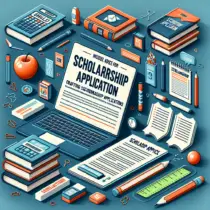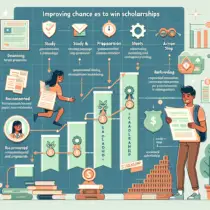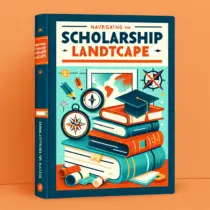Maximizing Your Chances for Winning a Scholarship
Winning a scholarship can significantly ease the financial burden of higher education. Whether it’s a $7,000 Coca-Cola Scholars Program Award, Japan, 2024, or a $300 Fine Art Development Grant, South Africa 2024, scholarships are highly competitive. However, understanding the key steps to improve your chances can put you ahead of the competition. This article provides an in-depth guide on how to maximize your chances.
Research Thoroughly
The first step in increasing your chances of winning a scholarship is to thoroughly research all available opportunities. Explore options like the $7,000 Coca-Cola Scholars Program Award, Japan, 2024, and see if you meet the eligibility requirements. Similarly, if you’re an artist, look into grants like the $300 Fine Art Development Grant, South Africa 2024.
Many students miss out on scholarships because they fail to find ones that suit their specific qualifications. Use scholarship databases, school counselors, and websites dedicated to financial aid to discover various scholarships. Create a spreadsheet to track submission deadlines and requirements.
Know the Requirements
Once you’ve identified potential scholarships, carefully review the eligibility criteria and application instructions. Each scholarship may have unique requirements, such as specific academic achievements, extracurricular activities, or essay questions. For instance, the $7,000 Coca-Cola Scholars Program Award might require a high GPA, essays, and community service.
Similarly, the $300 Fine Art Development Grant, South Africa 2024, may focus on your artistic portfolio and a statement of purpose. Ensure you fully understand what is required to tailor your application accordingly.
Tailor Your Application
A generic application will not stand out to scholarship committees. Tailor each application to highlight how you meet the specific criteria of the scholarship. If you’re applying for the Coca-Cola Scholars Program, emphasize your leadership roles, community service involvement, and academic achievements.
For the Fine Art Development Grant, focus on your artistic accomplishments, the development of your style, and how the grant will further your career. Use specific examples and personal anecdotes to make your application memorable.
Highlight Academic Excellence
Many scholarships, especially merit-based ones like the Coca-Cola Scholars Program Award, prioritize academic excellence. Ensure your grades and test scores are as high as possible. Prepare for standardized tests well in advance and consider retaking them if you believe you can improve your score.
Additionally, participate in Advanced Placement (AP) or International Baccalaureate (IB) courses to boost your GPA. Scholarships often require transcripts, so request them early to avoid any last-minute issues.
Display Leadership and Community Service
Leadership experience and community service are critical components of many scholarship applications. Participate in student government, clubs, or sports teams and strive to hold leadership positions. Volunteer in your community and document your hours and the impact of your work.
For example, if you plan to apply for the Coca-Cola Scholars Program Award, your commitment to leadership and community service can set you apart. Show your involvement in initiatives that align with the scholarship’s values.
Craft a Strong Personal Statement
A compelling personal statement or essay can be a deciding factor in your scholarship application. Take your time to write a thoughtful and well-organized essay. Address the prompt directly and incorporate your personal experiences, goals, and why you’re a strong candidate for the scholarship.
Proofread multiple times and ask teachers, mentors, or family members to review your essay. Clear writing with no grammatical errors creates a positive impression and can vastly improve your chances.
Secure Strong Letters of Recommendation
Strong letters of recommendation can significantly bolster your application. Choose recommenders who know you well and can speak to your qualifications, character, and potential. Ask teachers, counselors, or community leaders who have seen you in leadership roles or witnessed your academic prowess.
Provide your recommenders with the scholarship’s details and any specific points you’d like them to mention. This will help them write a focused and effective letter.
Apply Early
Procrastination can diminish your chances of winning a scholarship. Applying early demonstrates your seriousness and can reduce stress. Early applications also allow time for unforeseen issues, such as technical problems or missing documents.
Set personal deadlines well ahead of the actual submission dates. This gives you a buffer period to review and perfect your application materials.
Frequent Follow-ups
After submitting your application, follow up to ensure it was received and is complete. Contact the scholarship committee or organization to confirm everything is in order. A simple follow-up can underscore your interest and attention to detail.
Broaden Your Search
Don’t limit your search to highly competitive national scholarships like the Coca-Cola Scholars Program. Look for scholarships offered by local businesses, community organizations, and your future college or university. Smaller, less competitive scholarships can add up and significantly reduce your tuition costs.
Additional Tips on Scholarships Abroad
International scholarships offer unique opportunities to study in different cultural environments. For instance, the Coca-Cola Scholars Program Award can sometimes include international components like studying in Japan in 2024. Similarly, if you’re an artist, the $300 Fine Art Development Grant in South Africa for 2024 presents a chance to showcase your work globally.
Research any additional requirements for international scholarships, such as language proficiency tests or student visa applications. Meeting these criteria early can enhance your chances of selection.
Financial Need-Based Scholarships
If you fall into the category of financially burdened families, many scholarships take financial need into account. Fill out the Free Application for Federal Student Aid (FAFSA) to qualify for need-based financial aid programs. Some scholarships specifically target students from low-income backgrounds, where demonstrating financial need can strengthen your application.
Attending Scholarship Workshops and Seminars
Many high schools and colleges offer workshops and seminars on how to apply for scholarships. Attend these events to gain insights into successful application strategies. You can also network with other students and counselors who can provide advice and share lesser-known scholarship opportunities.
Online Courses and Certifications
Enrolling in online courses or earning certifications can also make your application stand out. Platforms like Coursera, Udemy, or edX offer various courses that can add value to your resume. A certification in a skill related to the scholarship you’re applying for can highlight your dedication and continued learning.
Keeping a Portfolio
For scholarships related to specific skills, such as art scholarships like the $300 Fine Art Development Grant, South Africa 2024, maintaining a portfolio is crucial. Continuously update and improve your portfolio to showcase your best work. A well-organized and high-quality portfolio can significantly bolster your application.
Final Words of Encouragement
Applying for scholarships can be a demanding process, but the rewards make it worthwhile. Keep a positive attitude, and don’t be discouraged by rejections. Each application you submit improves your chances and hones your skills for future opportunities.
Persistence, organization, and a keen understanding of the application process are your best tools for success. With these strategies, you’re well on your way to maximizing your chances of winning that coveted scholarship, whether it’s a generous $7,000 Coca-Cola Scholars Program Award or a supportive $300 Fine Art Development Grant.
Conclusion
Winning a scholarship requires careful planning, attention to detail, and a proactive approach. By researching opportunities, understanding requirements, tailoring your application, and showcasing your strengths, you can greatly increase your chances. Whether you’re aiming for the Coca-Cola Scholars Program Award in Japan by 2024, or the Fine Art Development Grant in South Africa by 2024, these steps will guide you toward achieving your educational goals.






